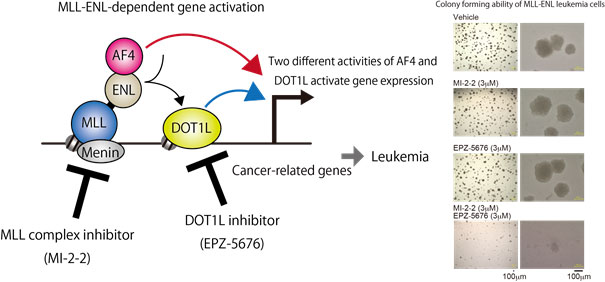Home > Information > press release > Elucidation of the mechanism of MLL-rearranged leukemia Use of two molecularly targeted drugs as novel therapy
Elucidation of the mechanism of MLL-rearranged leukemia Use of two molecularly targeted drugs as novel therapy
April 27,2017
National Cancer Center
Kyoto University Graduate School of Medicine
in Japanese
- DOT1L facilitates AF4-dependent gene activation
- MLL fusion proteins transform via two separate activities of AF4 and DOT1L
- Simultaneous inhibition of DOT1L and AF4 has synergistic anti-leukemic effects
Leukemia is a disease in which hematopoietic cells acquire mutations at immature stages and become immortalized while maintaining their undifferentiated state. The MLL gene is often fused with ENL and AF10 family of genes by chromosomal translocation, causing aggressive leukemia, for which current treatment regimens are not sufficiently effective. In cases of infant acute lymphoblastic leukemia, overall survival of MLL-rearranged leukemia patients is near 40% even with intensive chemotherapy followed by bone marrow transplantation, while non MLL-rearranged leukemia patients can be mostly cured by chemotherapy only. Thus, novel therapy that effectively eradicates MLL-rearranged leukemia cells needs to be developed.
Findings
Elucidation of molecular mechanism of MLL-rearranged leukemia
MLL mutant proteins such as MLL-ENL and MLL-AF10 associate various endogenous factors such as AF4 and DOT1L to exert their oncogenic functions. The research team employed the chromatin Immunoprecipitation method to identify genomic regions where MLL-ENL and its associated factors in leukemia cells. Generally, MLL-ENL co-localized with AF4 and DOT1L at the same chromatin regions (Figure 1). Association of AF4 was closely correlated with that of MLL-ENL, indicating MLL-ENL tethers AF4 to the target chromatin. Chromatin association of DOT1L was loosely correlated with the presence of MLL-ENL, but was not observed in some MLL-ENL target loci and was biased to coding regions, indicating other factors influence the chromatin binding of DOT1L. Structure/function analysis using mouse leukemia model revealed that the structures for association of both AF4 and DOT1L are required for induction of leukemia. Because DOT1L-dependent modification of chromatin reinforces AF4-dependent gene activation, the activities of both AF4 and DOT1L are required for the onset of leukemia.Use of two molecularly targeted drugs effectively eradicates leukemia stem cells in mouse disease model
Based on the notion that AF4 and DOT1L cooperatively activate gene expression in MLL-rearranged leukemia, we test the effects of simultaneous inhibition of AF4 and DOT1L. It was previously shown that association between the MLL mutant protein and MENIN is critical for the oncogenic activity of the MLL mutant protein complex (Figure 1). Recently a compound termed MI-2-2, which inhibits MLL/MENIN complex formation, was developed. Because chromatin association of AF4 depends on the formation of MLL/MENIN complex, MI-2-2 would inhibit AF4 recruitment. Chromatin-modifying activity of DOT1L can be inhibited by a compound called EPZ-5676. Both compounds were developed as molecularly targeted drugs for MLL-rearranged leukemia, but are still in the development stages. The propagation of leukemia stem cells were effectively inhibited by the simultaneous use of the two drugs, at the concentration where single reagent showed minimal effects. Even a three days exposure of two drugs dramatically hindered the development of leukemia after immediate transplantation of drug-exposed leukemia cells. Thus, the combinatorial use of these molecularly target drugs inhibits two key functions of MLL mutant proteins at the same time, and has a strong potential to improve current regimens in future.
Figure 1 Mechanism of MLL-rearranged leukemia
Mechanism of MLL-ENL-dependent gene activation(left). MLL-ENL recruits AF4 and DOT1L through the ENL portion. AF4 is constitutively tethered to the target chromatin by MLL-ENL, while DOT1L is recruited by MLL-ENL and tethered to nearby chromatin. MLL-ENL activates transcription via AF4, which can be inhibited by MI-2-2. DOT1L maintains transcriptionally active chromatin by chromatin modification, which can be inhibited by EPZ-5676. AF4 and DOT1L cooperatively activate gene expression by exerting two different functions. Simultaneous exposure to MI-2-2 and EPZ-5676 results in eradication of leukemia cells (right).Prospects
In this paper, the research team showed that the combinatorial use of an MLL/MENIN complex formation inhibitor and a DOT1L enzymatic activity inhibitor effectively eradicates leukemia stem cells. Because MLL mutant proteins depend on the activities of AF4 and DOT1L for gene expression, simultaneous inhibition of both activity impose significant anti-tumorigenic effects. As current regimens cannot cure many of the patients with this disease, the combinatorial use of these molecularly targeted drugs may improve the prognosis of patients in future.Publication
The Journal of Clinical Investigation
Cooperative gene activation by AF4 and DOT1L drives MLL-rearranged leukemia
Hiroshi Okuda, Boban Stanojevic, Akinori Kanai, Takeshi Kawamura, Satoshi Takahashi, Hirotaka Matsui, Akifumi Takaori-Kondo, Akihiko Yokoyama
Funding
KAKENHI grant (16H05337, to AY)A. Yokoyama was supported by research funding from Dainippon Sumitomo Pharma Co., Ltd.
Press release
Elucidation of the mechanism of MLL-rearranged leukemia Use of two molecularly targeted drugs as novel therapy (PDF)(PDF:205KB)Contact
National Cancer Center of JapanOffice of Public Relations, Strategic Planning Bureau
5-1-1 Tsukiji, Chuo-ku, Tokyo 104-0045, Japan
Tel:+81-3-3542-2511 (Switchboard)
FAX:+81-3-3542-2545
E-mail: ncc-admin[at]ncc.go.jp (Please replace [at] to @.)
